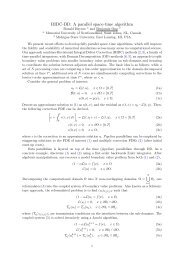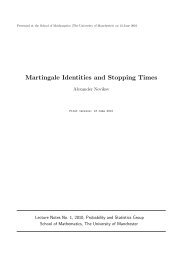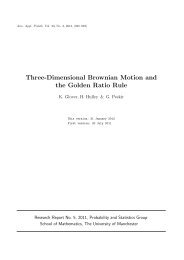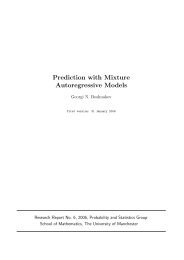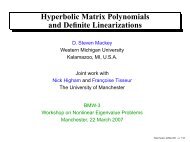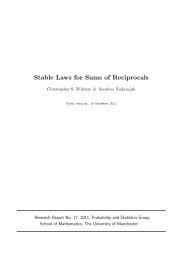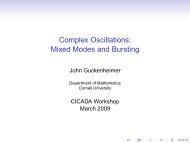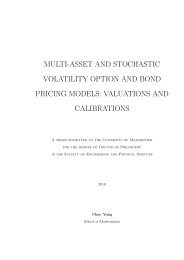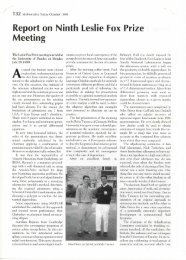Local Behaviour of First Passage Probabilities - MIMS - The ...
Local Behaviour of First Passage Probabilities - MIMS - The ...
Local Behaviour of First Passage Probabilities - MIMS - The ...
Create successful ePaper yourself
Turn your PDF publications into a flip-book with our unique Google optimized e-Paper software.
It is apparent that we will also need information about the behaviour <strong>of</strong>g(n; x); or equivalently <strong>of</strong> P (S n = x; > n); in the case x=c n ! 1. Fortunatelythis has been obtained recently in [19], and we quote Propositions 11and 12 therein as (28) and (30). <strong>The</strong> related unconditional results (27) and (29)have been proved in special cases in [12], [13], and [19], and the general resultscan be deduced from <strong>The</strong>orem 2.1 <strong>of</strong> [9].Proposition 14 If S is an asrw with < 1; then, uniformly for x such thatx=c n ! 1;P (S n > x) v nP (S 1 > x) as n ! 1; and (27)P (S n > x; > n) v 1 P (S n > x)P ( > n) as n ! 1: (28)If, additionally, (11) holds, thenP (S n 2 [x; x + )) v nf x as n ! 1 (29)andP (S n 2 [x; x + ); > n) v 1 nf x P ( > n) as n ! 1: (30)3.1 Some identities for stable processes.Proposition 15 (i) For any stable process Y which has < 1 there are positiveconstants k 7 and k 8 such that the following identities hold:Z 1h x (t) = k 7 q x (w)w dw and (31)Z1q u (v) = k 800u^v Z0u(t; u z)u (1 t; v z)dzdt; (32)where u and u denote the bivariate renewal densities for the increasing ladderprocesses <strong>of</strong> Y and Y:(ii) If = 1 there is a positive constant k 9 such thatp(x) = k 9 h x (1): (33)Pro<strong>of</strong>. All three results are special cases <strong>of</strong> results for Lévy processes. <strong>The</strong>general version <strong>of</strong> (31) is given in [15], and (32) follows from the followingobservation, which is a minor extension <strong>of</strong> <strong>The</strong>orem 20, p176 <strong>of</strong> [5].Assume X is a Lévy process which is not compound Poisson. <strong>The</strong>n there isa constant k 7 > 0 such that for x > 0 and w < x;P (X t 2 dw; t < T x )dt = k 7Z xy=w + Z ts=0U(ds; dy)U (dt s; y dw); (34)where U and U are the bivariate renewal measures in the increasing ladderprocesses <strong>of</strong> X and X : Clearly it su¢ ces to prove that the Laplace transform,8



